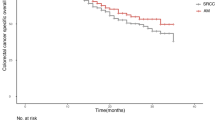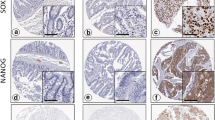Abstract
Purpose
Colorectal cancers of the proximal colon are characterized by good prognosis, microsatellite instability (MSI), and poor differentiation. MSI is associated with a favorable prognosis, but poorly differentiated adenocarcinomas (PDAs) have a poor prognosis. In this study, we aimed to investigate this inconsistency by analyzing the heterogeneity of PDAs.
Methods
A total of 156 surgically resected PDAs were analyzed according to tumor subsite by morphological and immunohistochemical analyses.
Results
Proximal PDAs (n = 86) were significantly associated with females, older age, cytokeratin (CK) 20 downregulation, aberrant MUC5AC expression, and MSI compared with distal PDAs (n = 70). Proximal PDAs tended to show a better overall survival rate than distal PDAs. PDAs with microsatellite stability (MSS) were suggested to progress from well- and moderately differentiated adenocarcinomas (WMDAs), but MSI PDAs typically not. MSI PDAs demonstrated a prognosis marginally better than MSS PDAs, but significantly worse than WMDAs (n = 170). Proximal MSS PDAs had a similar unfavorable prognosis but were significantly associated with females and aberrant MUC5AC expression compared with distal MSS PDAs. MSI may be predictive of prognosis only in proximal PDAs, because nearly all distal PDAs were MSS. In contrast, CK20 downregulation was significantly associated with better prognosis in both subsites.
Conclusions
Proximal PDAs had a better prognosis than distal PDAs due to a higher incidence of MSI PDAs, whose prognosis was significantly worse than WMDAs. Female and MUC5AC expression were characteristic of proximal PDAs independent of MSI. Subsite-specific features of PDAs may serve for subclassification and predicting prognosis.



Similar content being viewed by others
References
Iacopetta B (2002) Are there two sides to colorectal cancer? Int J Cancer 101:403–408
Bufill JA (1990) Colorectal cancer: evidence for distinct genetic categories based on proximal or distal tumor location. Ann Intern Med 113:779–788
Gervaz P, Bucher P, Morel P (2004) Two colons-two cancers: paradigm shift and clinical implications. J Surg Oncol 88:261–266
Weiss JM, Pfau PR, O'Connor ES, King J, LoConte N, Kennedy G, Smith MA (2011) Mortality by stage for right- versus left-sided colon cancer: analysis of surveillance, epidemiology, and end results—Medicare data. J Clin Oncol 29:4401–4409. doi:10.1200/JCO.2011.36.4414
Wray CM, Ziogas A, Hinojosa MW, Le H, Stamos MJ, Zell JA (2009) Tumor subsite location within the colon is prognostic for survival after colon cancer diagnosis. Dis Colon Rectum 52:1359–1366. doi:10.1007/DCR.0b013e3181a7b7de
Lengauer C, Kinzler KW, Vogelstein B (1997) Genetic instability in colorectal cancers. Nature 386:623–627
Haydon AM, Jass JR (2002) Emerging pathways in colorectal-cancer development. Lancet Oncol 3:83–88
Kim H, Jen J, Vogelstein B, Hamilton SR (1994) Clinical and pathological characteristics of sporadic colorectal carcinomas with DNA replication errors in microsatellite sequences. Am J Pathol 145:148–156
Jass JR, Do KA, Simms LA, Iino H, Wynter C, Pillay SP, Searle J, Radford-Smith G, Young J, Leggett B (1998) Morphology of sporadic colorectal cancer with DNA replication errors. Gut 42:673–679
Guastadisegni C, Colafranceschi M, Ottini L, Dogliotti E (2010) Microsatellite instability as a marker of prognosis and response to therapy: a meta-analysis of colorectal cancer survival data. Eur J Cancer 46:2788–2798. doi:10.1016/j.ejca.2010.05.009
Boland CR, Goel A (2010) Microsatellite instability in colorectal cancer. Gastroenterology 138:2073–2087. doi:10.1053/j.gastro.2009.12.064
Hamilton SR, Bosman FT, Boffetta P, Ilyas M, Morreau H, Nakamura SI, Quirke P, Riboli E, Sobin LH (2013) Carcinoma of the colon and rectum. In: Bozman FT, Carneiro F, Hruban RH, Theise ND (eds) WHO classification of tumours of the digestive system, 4th edn. IARC Press, Lyon, pp 134–146
American Joint Committee on Cancer (2009) Colon and rectum cancer staging, 7th edn. http://www.cancerstaging.org/staging/index.html. Accessed 18 October 2012
Imai Y, Yamagishi H, Fukuda K, Okamura T, Ono Y, Ban S, Inoue T, Ueda Y (2014) Expression of cytokeratin 20 indicates invasive histological phenotype in poorly differentiated colorectal adenocarcinoma. Anticancer Res 34:159–168
The Japanese Society for Cancer of the Colon and Rectum (2013) The general rules of Japanese classification of colorectal carcinoma, 8th edn. Kanehara, Tokyo
Marcus VA, Madlensky L, Gryfe R, Kim H, So K, Millar A, Temple LK, Hsieh E, Hiruki T, Narod S, Bapat BV, Gallinger S, Redston M (1999) Immunohistochemistry for hMLH1 and hMSH2: a practical test for DNA mismatch repair-deficient tumors. Am J Surg Pathol 23:1248–1255
Yamagishi H, Imai Y, Okamura T, Fukuda K, Ono Y, Ban S, Inoue T, Ueda Y (2013) Aberrant cytokeratin expression as a possible prognostic predictor in poorly differentiated colorectal carcinoma. J Gastroenterol Hepatol 28:1815–1822. doi:10.1111/jgh.12319
Kemp CJ, Wheldon T, Balmain A (1994) p53-deficient mice are extremely susceptible to radiation-induced tumorigenesis. Nat Genet 8:66–69
Smith ML, Fornace AJ Jr (1995) Genomic instability and the role of p53 mutations in cancer cells. Curr Opin Oncol 7:69–75
Starzynska T, Bromley M, Ghosh A, Stern PL (1992) Prognostic significance of p53 overexpression in gastric and colorectal carcinoma. Br J Cancer 66:558–562
Goh HS, Yao J, Smith DR (1995) p53 point mutation and survival in colorectal cancer patients. Cancer Res 55:5217–5221
Ishihara S, Watanabe T, Akahane T, Shimada R, Horiuchi A, Shibuya H, Hayama T, Yamada H, Nozawa K, Matsuda K, Maeda K, Sugihara K (2012) Tumor location is a prognostic factor in poorly differentiated adenocarcinoma, mucinous adenocarcinoma, and signet-ring cell carcinoma of the colon. Int J Colorectal Dis 27:371–379. doi:10.1007/s00384-011-1343-0
Sinicrope FA, Rego RL, Foster N, Sargent DJ, Windschitl HE, Burgart LJ, Witzig TE, Thibodeau SN (2006) Microsatellite instability accounts for tumor site-related differences in clinicopathologic variables and prognosis in human colon cancers. Am J Gastroenterol 101:2818–2825
Kim YH, Min BH, Kim SJ, Choi HK, Kim KM, Chun HK, Lee H, Kim JY, Chang DK, Son HJ, Rhee PL, Rhee JC, Kim JJ (2010) Difference between proximal and distal microsatellite-unstable sporadic colorectal cancers: analysis of clinicopathological and molecular features and prognoses. Ann Surg Oncol 17:1435–1441. doi:10.1245/s10434-009-0888-4
Greenblatt MS, Bennett WP, Hollstein M, Harris CC (1994) Mutations in the p53 tumor suppressor gene: clues to cancer etiology and molecular pathogenesis. Cancer Res 54:4855–4878
Iacopetta B (2003) TP53 mutation in colorectal cancer. Hum Mutat 21:271–276
Thompson SL, Bakhoum SF, Compton DA (2010) Mechanisms of chromosomal instability. Curr Biol 20:R285–R295. doi:10.1016/j.cub.2010.01.034
McGregor DK, Wu TT, Rashid A, Luthra R, Hamilton SR (2004) Reduced expression of cytokeratin 20 in colorectal carcinomas with high levels of microsatellite instability. Am J Surg Pathol 28:712–718
Biemer-Hüttmann AE, Walsh MD, McGuckin MA, Simms LA, Young J, Leggett BA, Jass JR (2000) Mucin core protein expression in colorectal cancers with high levels of microsatellite instability indicates a novel pathway of morphogenesis. Clin Cancer Res 6:1909–1916
Losi L, Scarselli A, Benatti P, Ponz de Leon M, Roncucci L, Pedroni M, Borghi F, Lamberti I, Rossi G, Marino M, Ponti G, Zangardi G, Menigatti M, Di Gregorio C (2004) Relationship between MUC5AC and altered expression of MLH1 protein in mucinous and non-mucinous colorectal carcinomas. Pathol Res Pract 200:371–377
Imai Y, Yamagishi H, Fukuda K, Ono Y, Inoue T, Ueda Y (2013) Differential mucin phenotypes and their significance in a variation of colorectal carcinoma. World J Gastroenterol 19:3957–3968. doi:10.3748/wjg.v19.i25.3957
Ionov Y, Peinado MA, Malkhosyan S, Shibata D, Perucho M (1993) Ubiquitous somatic mutations in simple repeated sequences reveal a new mechanism for colonic carcinogenesis. Nature 363:558–561
Cottu PH, Muzeau F, Estreicher A, Fléjou JF, Iggo R, Thomas G, Hamelin R (1996) Inverse correlation between RER+ status and p53 mutation in colorectal cancer cell lines. Oncogene 13:2727–2730
Gendler SJ, Spicer AP (1995) Epithelial mucin genes. Annu Rev Physiol 57:607–634
Hanski C, Riede E, Gratchev A, Foss HD, Böhm C, Klussmann E, Hummel M, Mann B, Buhr HJ, Stein H, Kim YS, Gum J, Riecken EO (1997) MUC2 gene suppression in human colorectal carcinomas and their metastases: in vitro evidence of the modulatory role of DNA methylation. Lab Invest 77:685–695
Ookawa K, Kudo T, Aizawa S, Saito H, Tsuchida S (2002) Transcriptional activation of the MUC2 gene by p53. J Biol Chem 277:48270–48275
Blank M, Klussmann E, Krüger-Krasagakes S, Schmitt-Gräff A, Stolte M, Bornhoeft G, Stein H, Xing PX, McKenzie IF, Verstijnen CP, Riecken EO, Hanski C (1994) Expression of MUC2-mucin in colorectal adenomas and carcinomas of different histological types. Int J Cancer 59:301–306
Mizoshita T, Tsukamoto T, Inada KI, Hirano N, Tajika M, Nakamura T, Ban H, Tatematsu M (2007) Loss of MUC2 expression correlates with progression along the adenoma-carcinoma sequence pathway as well as de novo carcinogenesis in the colon. Histol Histopathol 22:251–260
Hirano K, Nimura S, Mizoguchi M, Hamada Y, Yamashita Y, Iwasaki H (2012) Early colorectal carcinomas: CD10 expression, mucin phenotype and submucosal invasion. Pathol Int 62:600–611. doi:10.1111/j.1440-1827.2012.02850.x
Bartman AE, Sanderson SJ, Ewing SL, Niehans GA, Wiehr CL, Evans MK, Ho SB (1999) Aberrant expression of MUC5AC and MUC6 gastric mucin genes in colorectal polyps. Int J Cancer 80:210–218
Buisine MP, Janin A, Maunoury V, Audié JP, Delescaut MP, Copin MC, Colombel JF, Degand P, Aubert JP, Porchet N (1996) Aberrant expression of a human mucin gene (MUC5AC) in rectosigmoid villous adenoma. Gastroenterology 110:84–91
Bara J, Loisillier F, Burtin P (1980) Antigens of gastric and intestinal mucous cells in human colonic tumors. Br J Cancer 41:209–221
Bara J, Languille O, Gendron MC, Daher N, Martin E, Burtin P (1983) Immunohistological study of precancerous mucus modification in human distal colonic polyps. Cancer Res 43:3885–3891
Biemer-Hüttmann AE, Walsh MD, McGuckin MA, Ajioka Y, Watanabe H, Leggett BA, Jass JR (1999) Immunohistochemical staining patterns of MUC1, MUC2, MUC4, and MUC5AC mucins in hyperplastic polyps, serrated adenomas, and traditional adenomas of the colorectum. J Histochem Cytochem 47:1039–1048
Kim JH, Rhee YY, Bae JM, Cho NY, Kang GH (2013) Loss of CDX2/CK20 expression is associated with poorly differentiated carcinoma, the CpG island methylator phenotype, and adverse prognosis in microsatellite-unstable colorectal cancer. Am J Surg Pathol 37:1532–1541. doi:10.1097/PAS.0b013e31829ab1c1
Acknowledgments
I greatly appreciate Dr. Yamagishi H, Mr. Fukuda K, and Mr. Okamura T from Dokkyo Medical University Koshigaya Hospital for their excellent clerical and technical assistance.
Author information
Authors and Affiliations
Corresponding author
Rights and permissions
About this article
Cite this article
Imai, Y. Poorly differentiated adenocarcinoma of the colon: subsite location and clinicopathologic features. Int J Colorectal Dis 30, 187–196 (2015). https://doi.org/10.1007/s00384-014-2070-0
Accepted:
Published:
Issue Date:
DOI: https://doi.org/10.1007/s00384-014-2070-0




